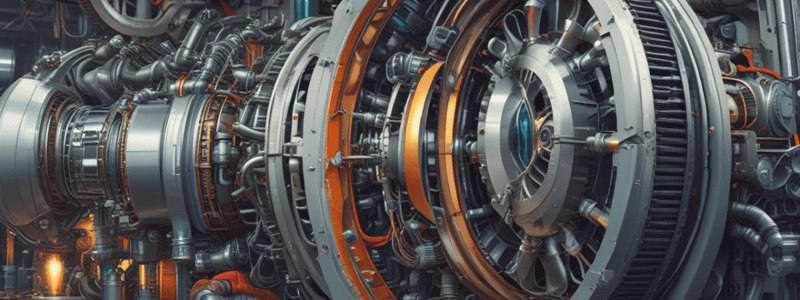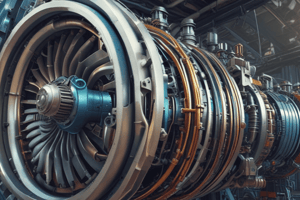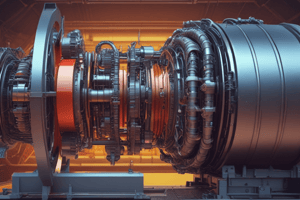Podcast
Questions and Answers
What is the advantage of permanent magnetic generators over brushed generators?
What is the advantage of permanent magnetic generators over brushed generators?
- They do not require power to be supplied to the field
- They are more efficient at high altitudes
- They have a longer lifespan due to fewer moving parts
- All of the above (correct)
How can permanent magnetic generators operate?
How can permanent magnetic generators operate?
- Neither voltage mode nor current mode
- In both voltage mode and current mode (correct)
- Only in voltage mode (open circuit)
- Only in current mode (closed circuit)
What are the crucial components that permanent magnetic generators provide power to?
What are the crucial components that permanent magnetic generators provide power to?
- Ignition exciter and FADECs (correct)
- Fuel pumps and hydraulic systems
- Landing gear and braking systems
- Environmental control systems and avionics
What type of alternators are used in large jet-powered aircraft?
What type of alternators are used in large jet-powered aircraft?
How does a brushless alternator induce current into the field coil?
How does a brushless alternator induce current into the field coil?
What are the three separate fields in a brushless alternator?
What are the three separate fields in a brushless alternator?
Which phase has a maximum voltage induced in the right-hand schematic?
Which phase has a maximum voltage induced in the right-hand schematic?
What does a 90° rotation of the rotor correspond to in the right-hand schematic?
What does a 90° rotation of the rotor correspond to in the right-hand schematic?
How are the voltages induced in phase A and phase B related in the waveform picture?
How are the voltages induced in phase A and phase B related in the waveform picture?
What is the configuration of a two-phase, three-wire alternator?
What is the configuration of a two-phase, three-wire alternator?
What effect does connecting one end of B1 to one end of A2 have on the output voltages?
What effect does connecting one end of B1 to one end of A2 have on the output voltages?
What is the result of adding the instantaneous values of phase A and phase B?
What is the result of adding the instantaneous values of phase A and phase B?
What is the phase difference between the voltages induced in any two phases of a three-phase alternator?
What is the phase difference between the voltages induced in any two phases of a three-phase alternator?
In a two-phase alternator, what is the output voltage at C in relation to the voltage of either phase A or B?
In a two-phase alternator, what is the output voltage at C in relation to the voltage of either phase A or B?
Which type of alternator is seldom seen in actual use?
Which type of alternator is seldom seen in actual use?
What is the advantage of a two-phase alternator over a single-phase alternator?
What is the advantage of a two-phase alternator over a single-phase alternator?
How are the voltages generated across each phase of a three-phase alternator represented in a schematic diagram?
How are the voltages generated across each phase of a three-phase alternator represented in a schematic diagram?
What is the phase relationship between the voltage waveforms generated across each phase of a three-phase alternator?
What is the phase relationship between the voltage waveforms generated across each phase of a three-phase alternator?
What type of waveform is commonly associated with alternating current?
What type of waveform is commonly associated with alternating current?
In which direction does direct current (DC) flow?
In which direction does direct current (DC) flow?
What eliminates the need to carry current to a rotating assembly through brushes?
What eliminates the need to carry current to a rotating assembly through brushes?
What type of waveform is a representation of induced EMF for a single coil rotated through a uniform magnetic field?
What type of waveform is a representation of induced EMF for a single coil rotated through a uniform magnetic field?
How does an alternating current (AC) flow compared to direct current (DC)?
How does an alternating current (AC) flow compared to direct current (DC)?
What produces a greater force to drive electrons when cutting lines of flux quickly?
What produces a greater force to drive electrons when cutting lines of flux quickly?
What is the purpose of a Constant Speed Drive unit in an aircraft?
What is the purpose of a Constant Speed Drive unit in an aircraft?
What determines the displacement of the axial-piston variable-displacement hydraulic pump in a Constant Speed Drive unit?
What determines the displacement of the axial-piston variable-displacement hydraulic pump in a Constant Speed Drive unit?
In an aircraft, how does a Constant Speed Drive unit help to maintain a uniform frequency between multiple generators?
In an aircraft, how does a Constant Speed Drive unit help to maintain a uniform frequency between multiple generators?
Which term is commonly used for hydraulic transmissions found on gas turbine engines' accessory drives?
Which term is commonly used for hydraulic transmissions found on gas turbine engines' accessory drives?
What type of modern aircraft generator is integrated with a Constant Speed Drive unit into a single unit known as IDG?
What type of modern aircraft generator is integrated with a Constant Speed Drive unit into a single unit known as IDG?
How does an Integrated Drive Generator (IDG) contribute to maintaining a constant AC frequency output in modern jet aircraft?
How does an Integrated Drive Generator (IDG) contribute to maintaining a constant AC frequency output in modern jet aircraft?
Flashcards are hidden until you start studying
Study Notes
Permanent Magnetic Generators vs. Brushed Generators
- Permanent magnetic generators offer higher efficiency due to the absence of brushes, reducing wear and maintenance needs.
- They operate using permanent magnets which create a magnetic field, allowing for simpler designs than brushed generators.
Operation of Permanent Magnetic Generators
- These generators utilize the principle of electromagnetic induction, where movement through a magnetic field generates electricity.
- Permanent magnets are crucial components, eliminating dependency on external power sources for excitation.
Power Supply of Permanent Magnetic Generators
- They primarily power aviation electrical systems, sensors, and control systems in aircraft.
- Support for auxiliary power units (APUs) and other ancillary equipment ensures continuous operation.
Alternators in Jet-Powered Aircraft
- Large jet-powered aircraft typically use brushless alternators, known for reliability and reduced maintenance.
- Brushless alternators enhance operational safety by eliminating brush wear.
Inducing Current in Brushless Alternators
- A brushless alternator induces current using a rotating magnetic field produced by permanent magnets or a rotor.
- It utilizes a rotating DC generator to produce AC voltage through electromagnetic induction.
Configuration of Brushless Alternators
- A brushless alternator has three separate fields arranged to ensure balanced output.
- The fields include the main rotor field, the exciter field, and the output field.
Voltage Induction in Right-Hand Schematic
- Phase A has a maximum voltage induced in the right-hand schematic during specific rotor positions.
- A 90° rotation of the rotor corresponds to a transition point between maximum and minimum induced voltages.
Voltage Relationship in Phase A and Phase B
- In the waveform picture, voltages induced in phase A and phase B are out of phase, representing the sinusoidal nature of AC.
- The combined output forms a resultant voltage that can be harnessed for electrical systems.
Configuration of Two-Phase, Three-Wire Alternator
- This configuration allows the sharing of a common return path, optimizing the wiring and simplifying the circuit design.
- Connecting B1 to A2 can influence the output voltage balance and phase relationship.
Results of Adding Phase A and Phase B Instantaneous Values
- The addition of instantaneous values can produce a resultant voltage that serves various electrical loads effectively.
- This provides a continuous power supply to multiple aircraft systems.
Phase Difference in Three-Phase Alternators
- The phase difference between voltages induced in any two phases of a three-phase alternator is typically 120°.
- This spacing ensures a balanced load and consistent power delivery.
Output Voltage of Phase C in Two-Phase Alternator
- The output voltage at phase C is directly related to the combined outputs of either phase A or B.
- This configuration assists in maximizing power output.
Less Common Alternator Types
- Various alternator designs exist, but certain configurations, such as some two-phase designs, are seldom seen in practical applications.
Advantages of Two-Phase Over Single-Phase Alternators
- Two-phase alternators offer improved power delivery and reduced ripple compared to single-phase alternators.
- Enhanced efficiency translates to better performance in aircraft systems.
Schematic Representation of Three-Phase Alternator Voltages
- Voltages across each phase are depicted in a schematic diagram as sine waves, emphasizing their phase relationship.
- The phase relationship is crucial for synchronized operations and load balancing in generators.
Waveforms Associated with AC and DC
- Alternating current (AC) is commonly represented by sinusoidal waveforms.
- Direct current (DC) flows consistently in one direction, providing stable output for various applications.
Elimination of Brushes and Current Carrying
- Designs like brushless alternators eliminate the need for brushes, enhancing longevity and reliability in electrically driven systems.
Induced EMF Representation
- The induced EMF for a single coil rotating within a magnetic field is illustrated as a sinusoidal waveform, showcasing varying potential differences.
Comparison of AC and DC Flow
- AC current alternates its direction, resulting in periodic changes, while DC flows uniformly in a single direction.
- This distinction affects their applications in electrical systems.
Factors Affecting Electromagnetic Force
- A greater force driving electrons is produced by rapidly cutting through magnetic flux lines, enhancing energy generation efficiency.
Constant Speed Drive (CSD) Unit Purpose
- The CSD unit maintains consistent generator speed, achieving reliable electrical output across varying engine speeds.
- It ensures synchronized performance among multiple power generators.
Axial-Piston Variable-Displacement Pump Determinants
- Displacement is determined by the control mechanisms within the pump, regulating hydraulic flow based on operational needs.
CSD in Aircraft Frequency Management
- The CSD unit’s design allows for uniform frequency maintenance, ensuring compatibility between engine speeds and electrical demands.
- This reliability reduces the risk of electrical failure during flight.
Hydraulic Transmissions in Gas Turbine Engines
- Hydraulic transmissions found in gas turbine engines' accessory drives are commonly referred to as Constant Speed Drives.
Integrated Drive Generator (IDG) Specification
- IDGs combine the generator and CSD into a single, efficient unit known for reliability and consistent output in modern aircraft.
Contribution of IDG to AC Frequency Control
- The IDG maintains a steady AC frequency output, ensuring electrical systems function properly without fluctuation, essential for aircraft operations.
Studying That Suits You
Use AI to generate personalized quizzes and flashcards to suit your learning preferences.




